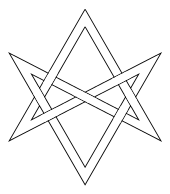

The unicursal hexagram is a hexagram or six-pointed star that can be traced or drawn unicursally, in one continuous line rather than by two overlaid triangles. The hexagram can also be depicted inside a circle with the points touching it. It is often depicted in an interlaced form with the lines of the hexagram passing over and under one another to form a knot. It is a specific instance of the far more general shape discussed in Blaise Pascal's 1639 Hexagrammum Mysticum.
Giordano Bruno[edit]
In his work titled Essays upon the Mathematics of Mordente: One Hundred and Sixty Articles against the Mathematicians and Philosophers of this Age (Prague: 1588),[2] Italian philosopher, cosmological theorist, and Hermetic occultist Giordano Bruno used the unicursal hexagram symbol to represent Figura Amoris ("figure of love")[2] part of the Hermetic trinity in his mathesis.[3][better source needed]
Thelema[edit]

In Aleister Crowley's Thelema, the hexagram is usually depicted with a five-petalled flower in the centre which symbolises the pentagram. The hexagram represents the heavenly macrocosmic or planetary forces and is a symbol equivalent to the Rosicrucian Rose Cross or ancient Egyptian ankh. The five petals of the flower represent the microcosmic forces of 5 elements of the magical formula YHShVH and is a symbol equivalent to the pentagram or pentacle. The two symbols together represent the interweaving of the planetary and elemental forces.[4]
See also[edit]
References[edit]
- ^ Walker, Barbara G. (1988). The Woman's Dictionary of Symbols and Sacred Objects. HarperOne. p. 69. ISBN 0-06-250923-3.
- ^ a b Chou, Peter Y. "Notes to Poem: Pondering about Poetry after a Billy Collins reading at Stanford". Retrieved 2023-05-14.
- ^ "Unicursal Hexagram Meaning, Symbolism And Origins Explained". 2021-05-05. Retrieved 2021-05-21.
- ^ Duquette, Lon Milo (2003). Understanding Aleister Crowley's Thoth Tarot. Weiser. pp. 43–53. ISBN 1578632765.